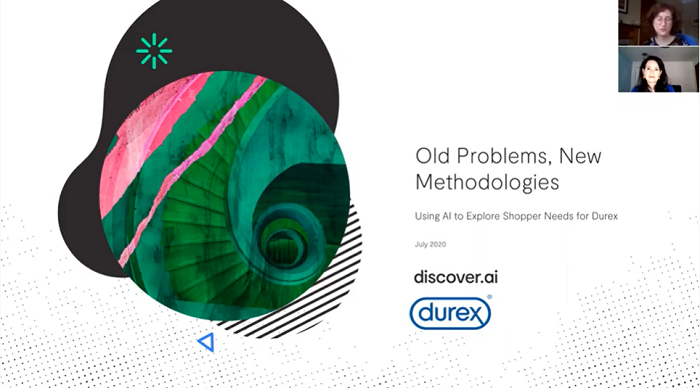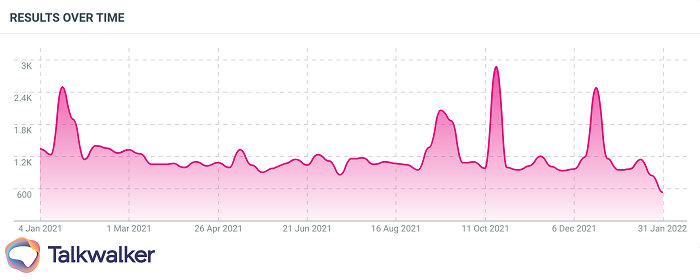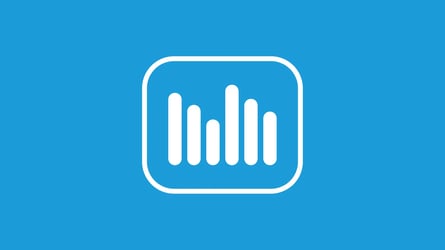Discover consumer intelligence inspiration
When I started at my first ever real job, I worked in a large open-plan office. People could see each others’ screens – not the details, but the larger things. This meant I would quite often have co-workers I didn’t know coming up to me and asking about my unusual desktop background. It’s my favorite piece of art, I’d reply. It’s called Another Storm by Lee Krasner. I like it because it reminds me of how I feel when I’m on my period.

Another Storm, by Lee Krasner. Krasner, incidentally, was married to Jackson Pollock and is unfairly much less famous.
The reactions to this were always varied, but most people found, after their initial shock or surprise, that they were quite capable of having a normal conversation about a completely natural bodily function without fainting or vomiting.
Breaking taboos is a sensitive subject
I’ve always enjoyed breaking taboos. There’s something about playing with the rules of conversation, of exploring why some things are forbidden and whether they really need to be – but as a researcher, that’s where the really interesting insights lie. In the unspoken, the later spoken, the only spoken with those one feels really comfortable with.
However, I’d thought my serious workplace taboo breaking would be restricted to internal culture changes brought about through open conversation. It was only when I joined discover.ai/Talkwalker*, that I found that this could be something that I could bring to my client work as well. And the thing that made this possible, was that I was suddenly immersed in social data and social media analytics.
‘Taboo’ is an interesting concept. It contains a sense of the ‘unspoken’, but that in itself is a contradiction. Taboo topics are those which are spoken about, but without the sense of safety that comes with ‘normal’ communication topics. Taboo topics are those which come with a risk of repercussion in raising them, and therefore ones where people don’t always want to be directly associated with the thing they want to say, for fear of shame, embarrassment or even punishment.
Hiding openly on the Internet
Enter – the internet. Since its inception, the internet has been a space where people have embraced anonymity and distance to say the things they would not say to people’s faces, in ‘real life’.
Quite often, when I take a brief, I have to say to my clients – you need to be realistic about whether people are really going to be talking about this online, in a manner that will be useful. But when it comes to taboo topics – menstruation, sex, mental health, erectile dysfunction, condoms, incontinence, menopause, cervical cancer (all real project topics) – I never have that worry.
Traditional research vs the Internet
What’s brilliant about this is that it is the opposite reaction that my clients are used to when it comes to doing traditional market research. In interviews or focus groups, you have to build a careful rapport with your respondents in order to help them feel comfortable opening up on sensitive topics in a way that feels safe.
On the internet, they’ll do it for you, and gladly.
Understand taboo topics with social data analysis
When we presented some of our work with Durex on understanding the behaviors of their consumers, we called the presentation, Using the newest methodologies to understand the world’s oldest problems.
Click above to watch the Old Problems, New Methodologies presentation (Only available on YouTube)
I think this goes to the heart of what’s so inspiring about using social data to understand taboo topics. The reason that people are going online to talk about the things they can’t talk about anywhere else is that the silencing that turns natural bodily processes and common conditions into something shameful means that people are going online looking for help.
They are sharing knowledge and advice, and seeking it in return, because this is something they’re not getting in traditional spaces. Brands who want to truly help their consumers, and to find ways to make genuine change in spaces that have been calling out for it for decades, can tap into this using social data and AI research. They can find new perspectives on these old, pervading problems.
As with any form of research, there are watch-outs and there are dangers. We build source data from consumer forums, discussion groups, book reviews, expert sites, bloggers, influencers – anywhere that someone might be sharing their feelings and reactions. But the very thing that makes this so rich also makes it risky.
Don't be a stranger
We saw in a project understanding vaginal pain conditions like vulvodynia and vaginismus, produced in collaboration with Jessica Marcus (Storyful), that people would go to r/sex to understand why they couldn’t have sex with their partners, and a stranger on the internet would end up diagnosing them at a distance. Often this would then empower their conversations with their doctor – but also leaves them vulnerable to misinformation and quack remedies.
Talkwalker’s Quick Search identified 68.8k mentions of vulvodynia and vaginismus over 13 months. But it requires human insight and analysis to learn more from that data.
Avoid online echo chambers
We also have to work as hard as possible to ensure that our data is coming from diverse sources. Social data can cut across and share voices from people of different ethnicities, races, religions, gender identities, and those with disabilities or chronic conditions.
These are all people who might find structural and logistical barriers to attending focus groups, or who might not be heard if they are present. But bias is ever present, and we must strive to avoid online echo chambers, and ensure our data accurately represents as wide a gamut of voices as possible.
Humans + AI = real solutions
This is why it’s always so important for us to combine human sensitivity in our analysis of AI and social media data. The AI does not know which science is real, or which voices are ‘bad actors’. Technology can help us get to new perspectives, but it is the humans working with it who will come up with the real, working solutions.
Period-talk is no longer a code red
It has been a long time since anyone has been ‘shocked’ by my desktop background. Working in an environment comfortable with common taboo subjects and challenging insight, talking about my period at work is not a notable event.
Find data, human & cultural insights
But our immersion in these topics never quite prepares you for the moment of shock when you realize all of the ways in which people’s lives, their health, their reality are impacted by not being able to talk openly about the things that matter to them. Finding the data is only the first challenge, and we have the tools to do that – but what we do with that information, is the bigger, more pressing challenge, and that is where the real work begins.
When Talkwalker acquired discover.ai, a consumer and cultural insight platform, it created a unique combination of machine learning and human insight. This means we now provide our clients with a deeper reading into the human stories and emotive human drivers that lie behind consumer intelligence.
If you’d like to find out more, you can sign up for a personalized demo. To help with your research, download our consumer behavior dashboard…






